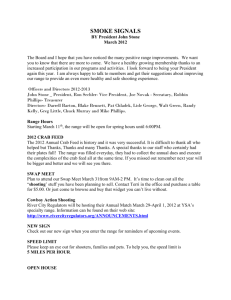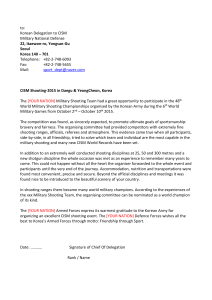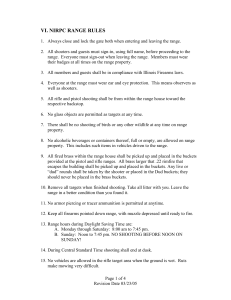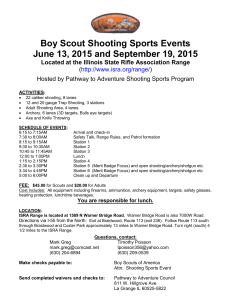SHOOTING RANGE SAFETY STANDARDS
advertisement
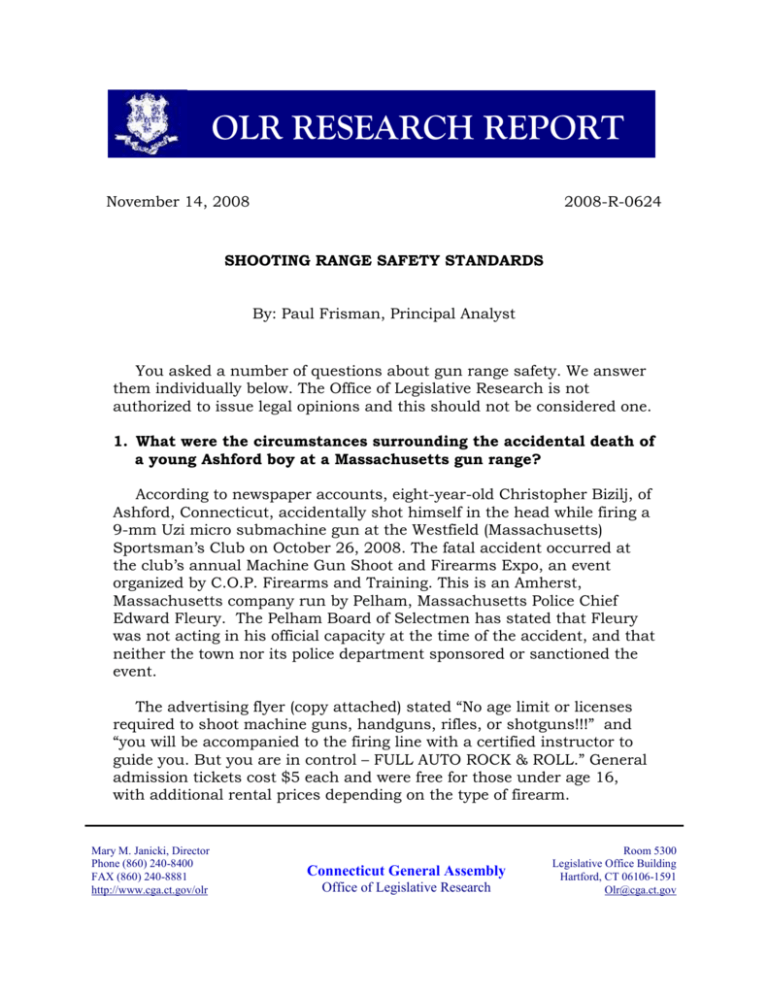
OLR RESEARCH REPORT November 14, 2008 2008-R-0624 SHOOTING RANGE SAFETY STANDARDS By: Paul Frisman, Principal Analyst You asked a number of questions about gun range safety. We answer them individually below. The Office of Legislative Research is not authorized to issue legal opinions and this should not be considered one. 1. What were the circumstances surrounding the accidental death of a young Ashford boy at a Massachusetts gun range? According to newspaper accounts, eight-year-old Christopher Bizilj, of Ashford, Connecticut, accidentally shot himself in the head while firing a 9-mm Uzi micro submachine gun at the Westfield (Massachusetts) Sportsman’s Club on October 26, 2008. The fatal accident occurred at the club’s annual Machine Gun Shoot and Firearms Expo, an event organized by C.O.P. Firearms and Training. This is an Amherst, Massachusetts company run by Pelham, Massachusetts Police Chief Edward Fleury. The Pelham Board of Selectmen has stated that Fleury was not acting in his official capacity at the time of the accident, and that neither the town nor its police department sponsored or sanctioned the event. The advertising flyer (copy attached) stated “No age limit or licenses required to shoot machine guns, handguns, rifles, or shotguns!!!” and “you will be accompanied to the firing line with a certified instructor to guide you. But you are in control – FULL AUTO ROCK & ROLL.” General admission tickets cost $5 each and were free for those under age 16, with additional rental prices depending on the type of firearm. Mary M. Janicki, Director Phone (860) 240-8400 FAX (860) 240-8881 http://www.cga.ct.gov/olr Connecticut General Assembly Office of Legislative Research Room 5300 Legislative Office Building Hartford, CT 06106-1591 Olr@cga.ct.gov According to the Boston Globe, a professional instructor familiar with the weapon was beside Christopher when he pulled the trigger. The weapon, capable of firing 1,200 rounds a minute, apparently recoiled upwards and backwards, firing a single bullet that struck Christopher in the head. The boy’s father, who had given him permission to fire the weapon, was standing behind his son when the accident occurred. According to the Globe, a Massachusetts firearms company owner stated that the micro Uzi “has such a high rate of fire that even adults have a lot of difficulty controlling it” (“Questions Grow After Uzi Death of Child,” Boston Globe, November 8, 2008). Hampden County (Massachusetts) District Attorney William M. Bennett is investigating the incident, together with state and local police and the federal Bureau of Alcohol, Tobacco, and Firearms. Bennett, in an October 28 press release, said investigators will determine if there was a violation of Massachusetts gun laws. Bennett said he had not found any “lawful authority which allows an eight-year-old to possess or fire a machine gun.” He also said investigators will seek to determine if allowing the third-grader to use a fully loaded automatic weapon was a “reckless or wanton” act. 2. What is being proposed in Massachusetts in light of the accident? The Massachusetts legislature’s Public Safety and Homeland Security Committee had planned to hold a November 17 hearing as a first step in drafting legislation on who may discharge a firearm and the conditions for handling firearms. Committee co-chairman Michael A. Costello (DNewburyport) said “We want to find out [about gun club] licensing procedure and what regulations exist (“Questions Grow After Uzi Death of Child,” Boston Globe, November 8, 2008.) But the Springfield Republican reported on November 12 that the legislature has cancelled the hearing and will reschedule it after the district attorney concludes his investigation. 3. What are the statutory firing range safety and supervision standards and requirements regarding children using firearms or visiting Connecticut firing ranges? Shooting ranges are generally regulated by towns, and very few state laws pertain to them. We found some local ordinances banning the discharge of firearms except for people using them on approved shooting ranges, but none of these address the safety of minors at a shooting range. November 14, 2008 Page 2 of 5 2008-R-0624 For example, Avon prohibits people under the age of 16 from firing weapons within town boundaries, but exempts from the ban a minor under the age of 16 who fires a weapon in the presence and under the supervision of a parent or legal guardian or qualified instructor on an authorized range (Avon Municipal Ordinances, § 36-1 (a)). Darien exempts from its ban on discharging a firearm in the town, among others, anyone shooting at a rifle, revolver, pistol, or trap and skeet range authorized in writing by the police chief (Darien Town Code § 38-22 (3)). State law allows the temporary transfer of handguns to people under age 21 for target or shooting practice, as long as the minor is under the immediate supervision of someone eligible to possess handguns (CGS § 29-34 (b)). But the law does not specify range safety standards. State law permits the state Board of Education and Connecticut Police Chiefs Association to prepare curriculum guides to help school boards develop firearms safety programs for students in grades K through eight. But the law (CGS § 10-18b) does not refer to shooting range safety. Statutes concerning shooting ranges include one allowing the use of firing ranges on Sundays, another allowing certain civilian rifle clubs to use state-operated or controlled rifle ranges, subject to the adjutant general's guidelines, and a third permitting certain civilian rifle clubs to use rifle and pistol ranges belonging to the state police (CGS §§ 27-35, 27-36, and 29-10a). A fourth statute exempts shooting range owners, operators, and users from criminal or civil liability for noise pollution on ranges that were operating on October 1, 1998 (CGS § 22a-74a). 4. Who can operate an assault weapon at a Connecticut shooting range? State law bans assault weapons. But anyone who owned such a weapon before the ban and holds a certificate of possession for it can have such a weapon at a shooting range, and other specified places (CGS § 53-202d). Connecticut law defines Uzi carbines, mini-carbines, and pistols as assault weapons (CGS § 53-202a (a)). The law bans these weapons. Illegal possession is generally considered a class D felony, punishable by one to five years in prison, and up to a $5,000 fine (CGS § 53-202c (a)). The ban does not apply to certain law enforcement personnel and members of the military who use the weapon in the course of their official duties (CGS § 53-202c (b)). November 14, 2008 Page 3 of 5 2008-R-0624 It also does not apply to an individual who applied to the Public Safety Department for a certificate of possession for the weapon before July 1, 1994 and lawfully possessed the weapon before October 1, 1993 (CGS § 53-202c (c)). But such an individual may possess the assault weapon only under six specific conditions, which include while on: 1. the premises of a target range of a public or private club or organization organized for the purpose of target shooting; 2. a target range which holds a regulatory or business license for the purpose of target shooting; and 3. the premises of a licensed shooting club (CGS § 53-202d (d)). The law also generally specifically prohibits the sale or transfer of an assault weapon to another, and specifically prohibits anyone from transferring, selling, or giving one to a person under 18 years old. A person who illegally sells or gives an assault weapon faces a maximum prison sentence of 10 years, of which two years cannot be suspended or reduced. If the recipient is younger than 18 years, the violator faces an additional mandatory minimum six-year prison sentence (CGS § 53-202b (a)). 5. What, if any, statutory provisions need to change to improve the safety of children at firing ranges? The legislature could explicitly prohibit children under a certain age from firing or possessing specified weapons at shooting ranges. Alternatively, it might require ranges to adopt certain safety measures and require periodic inspections to ensure that these standards are met. If the legislature believes such matters are best left to municipal regulation, it might consider legislation requiring the drafting of a model ordinance that municipalities might adopt. 6. What are nationally recognized standards for children’s safety at firing ranges? Although several associations or organizations, such as the National Association of Shooting Ranges (NASR) and the National Rifle Association (NRA) provide guidance on shooting range design, these guidelines primarily deal with such issues such as range layout, noise reduction, bullet containment, and lead poisoning prevention. November 14, 2008 Page 4 of 5 2008-R-0624 NASR’s Rick Patterson states that it is difficult to draft standards for firing ranges because shooting range conditions and procedures vary widely. He says that shooting range safety is not a major problem. The NRA, which has an extensive education and training component, does not certify or approve shooting ranges. According to its website, (http://www.nrahq.org/education/training/basictraining.asp#rso) its Range Safety Officer Course trains NRA Certified Range Safety Officers to oversee and supervise safe shooting activities and range operations. The course is nine hours long and is conducted in a classroom and at a shooting facility. John Frazer, research director for the NRA’s Institute for Legislative Action, states that the NRA does not have the resources to inspect thousands of gun ranges. “More to the point,” he said, “ranges should have good rules in place. The most important thing is that people supervising ranges [must be] vigilant all the time.” PF:ts November 14, 2008 Page 5 of 5 2008-R-0624
